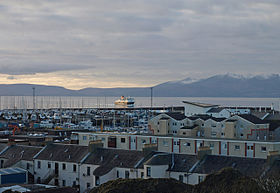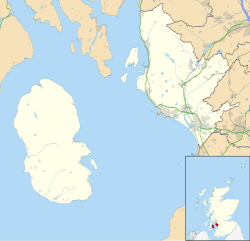|
North Ayrshire
North Ayrshire (Scottish Gaelic: Siorrachd Àir a Tuath, pronounced [ˈʃirˠəxk aːɾʲ ə ˈt̪ʰuə]) is one of 32 council areas in Scotland. The council area borders Inverclyde to the north, Renfrewshire and East Renfrewshire to the northeast, and East Ayrshire and South Ayrshire to the east and south respectively. The local authority is North Ayrshire Council, formed in 1996 with the same boundaries as the district of Cunninghame which existed from 1975 to 1996. Located in the west central Lowlands with the Firth of Clyde to its west, the council area covers the northern portion of the historic county of Ayrshire, in addition to the islands of Arran and The Cumbraes from the historic county of Buteshire.[3] North Ayrshire has a population of roughly 133,490 people.[2] Its largest towns are Irvine and Kilwinning. HistoryNorth Ayrshire was created in 1996 under the Local Government etc. (Scotland) Act 1994, which replaced Scotland's previous local government structure of upper-tier regions and lower-tier districts with unitary council areas providing all local government services. North Ayrshire covered the same area as the abolished Cunninghame district, and also took over the functions of the abolished Strathclyde Regional Council within the area.[4] The area's name references its location within the historic county of Ayrshire, which had been abolished for local government purposes in 1975 when Cunninghame district and Strathclyde region had been created, although the islands of Arran and The Cumbraes had been in Buteshire prior to 1975.[5] North Ayrshire forms part of the Ayrshire and Arran lieutenancy area.[6] GeographyThe council headquarters are located in Irvine, which is North Ayrshire's largest town. The area also contains the towns of Ardrossan, Beith, Dalry, Kilbirnie, Kilwinning, Largs, Saltcoats, Skelmorlie, Stevenston, West Kilbride, as well as the Isle of Arran and Great and Little Cumbrae. The Isle of Arran covers nearly half of the council area's territory, but is home to less than 4% of the population. North Ayrshire is known for its rural countryside, coastlines, beaches and landmarks. The towns in the north of the area, Skelmorlie, Largs, Fairlie and West Kilbride are affluent commuting towns and with them being on the coast, are very popular with tourists during the summer months. Towns in the south include Ardrossan, Saltcoats and Stevenston. Towards the south of the area is Kilwinning and Irvine, the main settlement and largest town in the area. The inland towns of Dalry, Kilbirnie and Beith were steel towns with large steel mills, but these are long gone. Tourism is the main industry on Arran and Cumbrae; however, the number of holiday homes on the latter has begun to squeeze locals out of the housing market. Regeneration is currently taking place at Ardrossan Harbour and Irvine town centre, and there has been a rapid increase in the construction of new housing in recent years. Kelburn Castle, Fairlie, is the home of the 10th Earl of Glasgow, Patrick Robin Archibald Boyle. The grounds have belonged to the Boyle family since the 1100s. In 2007, the castle was transformed by the Graffiti Project. Economy  North Ayrshire has a slightly higher level of unemployment compared to the Scottish average. North Ayrshire launched an Economic Recovery and Renewal Strategy in September 2020 focusing on economic recovery and a renewal approach which aims to sets out a comprehensive plan for an inclusive and green economic recovery for North Ayrshire. An £8.8 million Investment Fund will be used as a key element of a Green New Deal by:[7]
In May 2020, North Ayrshire Council became the first council in Scotland to become a Community Wealth Building (CWB) Council, setting out a new economic model focused on wellbeing and inclusion. North Ayrshire Council seeks to use Community Wealth Building objectives to support the recovery and renewal of North Ayrshire by creating an economy that works for people, place and planet. The North Ayrshire approach will see the creation of a new £660,000 Community Wealth Building Business Fund to provide assistance to local business and facilitating the development of co-operatives, employee ownership and social enterprises, supporting local supply chains, fair employment, digital adoption and the transition to a green economy. North Ayrshire is to benefit from the Ayrshire Growth Deal, an economic plan created by both the Scottish Government and UK Government. The £250 million Ayrshire Growth Deal is also central to the plans to support economic recovery through a bold and ambitious investment programme to create and secure jobs within the area of North Ayrshire.[7] EducationEducation in North Ayrshire is provided by North Ayrshire Council, the local authority responsible for the area. Education is provided to children in the area through early years centres, primary schools, secondary schools, home schooling and additional support need facilities.[8] There are currently ten secondary schools in North Ayrshire, all under the responsibility of North Ayrshire Council – Ardrossan Academy, Arran High School, Auchenharvie Academy, Garnock Community Campus, Greenwood Academy, Irvine Royal Academy, Kilwinning Academy, Largs Academy, Lockhart Campus and St Matthew's Academy.[9] Governance
 The council has been under no overall control since 2007, with various minority administrations led by both Labour and the Scottish National Party (SNP) operating since then. Following the 2022 election the council is under no overall control, being led by an SNP minority administration.[12] The next election is due in 2027. Political controlThe first election to North Ayrshire Council was held in 1995, initially operating as a shadow authority alongside the outgoing authorities until the new system came into force on 1 April 1996. Political control of the council since 1996 has been as follows:[13]
LeadershipThe leaders of the council since 1996 have been:[14]
CompositionFollowing the 2022 election, subsequent by-elections in May 2024 & September 2024, and the defection of two Conservative members of the Council to Reform UK, the composition of the council was:
The next election is due in 2027.[16] ElectionsSince 2007 elections have been held every five years under the single transferable vote system, introduced by the Local Governance (Scotland) Act 2004. Election results since 1995 have been as follows:[13][17]
PremisesThe council is based at Cunnninghame House on Friars Croft in Irvine, which was built in 1975 as the headquarters for the Cunninghame District Council, forming part of the new town centre for Irvine following its designation as a New Town.[22][23][24] WardsAs of 2022, the council area is divided into nine multi-member wards returning 33 members, composed as follows:[21]
Wider politicsAt the House of Commons, North Ayrshire is covered by the Central Ayrshire and North Ayrshire and Arran Parliamentary constituencies, both of which are represented by MPs belonging to the Scottish Labour Party. In the Scottish Parliament, the council area is divided into Cunninghame North and Cunninghame South, both represented by MSPs from the Scottish National Party. The council has been a member of the Islands Forum since 2022. SettlementsThe main administration centre and largest settlement in North Ayrshire is Irvine, a new town on the coast of the Firth of Clyde. The second biggest settlement is Kilwinning, followed by Saltcoats which is part of the 'Three Towns' - Ardrossan, Saltcoats and Stevenston. On the Isle of Arran, the largest village is Lamlash and there are numerous smaller villages. On Great Cumbrae, the only town on the island is Millport. Largest settlements by population:
Towns (mainland)Villages (mainland) 
Suburbs (mainland)
Villages (Isle of Arran)
Settlements (Great Cumbrae)Places of interest
References
External links
|
|||||||||||||||||||||||||||||||||||||||||||||||||||||||||||||||||||||||||||||||||||||||||||||||||||||||||||||||||||||||||||||||||||||||||||||||||||||||||||||||||||||||||||||||||||||||||||||||||||||||||||||||||||||||||||||||||||||||||||||||||||||||||||||||||||||||||||||||||||||||||||





